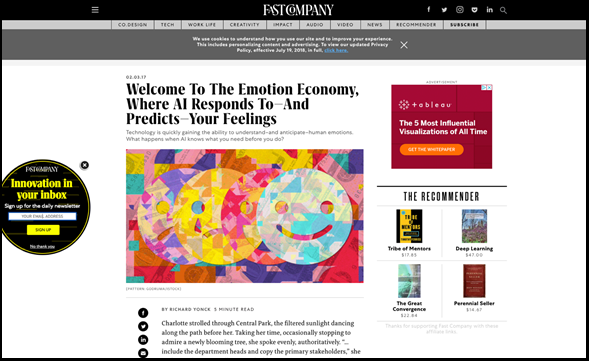
When your biggest competitor is the world-famous Massachusetts Institute of Technology, universally known as MIT, and you are a minnow based in Israel, then you’re always going to have an uphill struggle to get noticed. But undaunted, the cleverly named Beyond Verbal, is developing voice-enabled artificial intelligence products for personalized healthcare screening, has managed to earn major editorial links from the likes of Fast Company, The New York Times and Newsweek. And they did it, not by explaining how their software worked, but by showing how it worked through case studies, published research and some very clever public relations work.

Beyond Verbal was founded only in 2012 by Yoram Levanon, also the chief scientist who is behind their media strategy as well as leading the research and development side.
The company says that its technology enables machines to understand human emotions by analyzing raw voice intonations as people speak. This particular niche falls into the recently coined term of ‘Emotion Economy’.
While that could be seen by some cynics as a bit “new-age-ish”, the science behind it, although complex, is aimed at more quotidian health matters, such as cardiovascular disease and depression.
One possible problem, however, is the sense that we are entering some sort of dystopian world of strange goings-on, a la Keanu Reeves’ Matrix. We are at the start of our understanding of AI and many people are confused.
With that in mind, Beyond Verbal puts a lot of effort into debunking those myths by the simple expedient of explaining the science.
Make the case
Beyond Verbal publishes case studies to bolster its reputation as a serious scientific outfit.
“Case studies can serve a wide range of functions for all of your teams but they are also fantastic for letting the press in on what you do,” it says.

The company has a good stock of case studies shared via different media — from static PDFs through video — to highlight their product and some of its applications.
This makes it easier not just to attract reporters, but to efficiently clue them in.
“By the time you speak with them, they are asking extremely targeted questions and saving you time from having to review company basics.”
Levanon reads the news every day and closely monitors what is being covered. “All the news you read, look at how it applies to you,” he says. “Always think about how what you read or watch might relate to your product or company.”
Be creative
For example, the tie-in between politics and Beyond Verbal’s AI technology might not seem immediately visible. And yet, The Huffington Post chose to cover how “Beyond Verbal’s New App Tells You How Cheating Politicians Really Feel,” even adding in some video content to demonstrate how compelling their product’s features are.

This valuable publicity focused on Beyond Verbal’s app ‘Moodies’, which the Huffington Post used to analyse an ‘apology” from a cheating US politician, even if that might be seen as setting the bar low.
Importantly,
Beyond Verbal’s vice president of marketing and strategic accounts, Dan Emodi
(er, ‘Emoji’, anyone?). was able to elaborate in the article: “Our goal is to introduce emotional understanding into practically
everything we do, including human-to-human interactions, driving cars, playing
games, improving service, or getting better commercials.”
“We’re going from our cognitive communication – what we say – to our
emotional communication, which is our body language and vocal intonation.”
For Beyond Verbal, any news situation that involves complex emotions provides an opportunity to demonstrate how their product works. There is a danger that in this nascent technology, Beyond Verbal’s suite of products might be seen more like science fiction than science, so it is important to seek the approbation and endorsement of major media outlets.
Conference call
That means keeping your name on people’s lips. This increases the probability of successful word-of-mouth praise reaching a reporter’s ears. But you can tip the scales in your favour by being strategic with where your company appears.
One underutilized venue noted by Levanon includes trade shows and industry conferences: “There’s always some media presence at these events. Keeping that in mind while networking, you’ll keep your brand on people’s lips and demonstrate that you are an active member of the industry,” he says.
Keep an eye on the opposition
Attending conferences is one way to start keeping an eye on what competitors are doing, but you should keep an eye on the directions they’re taking.
“In order to distinguish yourself from the competition, you need to know what they are doing,” advises Levanon. MIT is Beyond Verbal’s biggest competitor; but while MIT is examining depression, Beyond Verbal is able to take their product to companies such as corporate call centres.
Also, look at where your competitors are earning coverage — and with which reporters —so you can tap them up.
It shouldn’t be surprising that a company like Beyond Verbal, whose core mission is to get at the messages and emotions beyond just the words people use, has managed to accurately read the press landscape and crack the code on coverage.
At its core, media attention gives you a chance to explain why you do what you do. Whether you offer products or services, you exist to meet a need. A highly technical or esoteric business may have a harder time making this need clear to the public, but there is always a story to tell of an unmet need being served by you.
If you want to read further into PR, we have a selection of articles for you to read:
Editorial Links are just part of business for Warby Parker
Getting creative with PR: Calm.com shows the way
PR Lessons as UK Small Business earns impressive editorial links
- How a Small AI Company Gained Backlinks From Major US News Publications - June 24, 2019
- Getting creative with PR: Calm.com shows the way - November 21, 2018
- PR Lessons as UK Small Business earns impressive editorial links - October 18, 2018







great post
July 10, 2019 at 6:53 amso kind of you
thanks
Thanks for sharing the article.
July 22, 2019 at 7:44 am